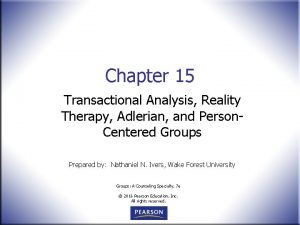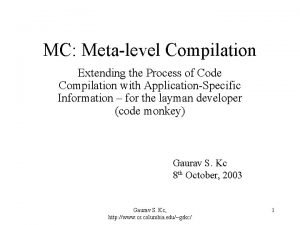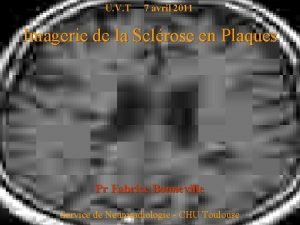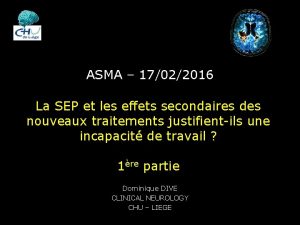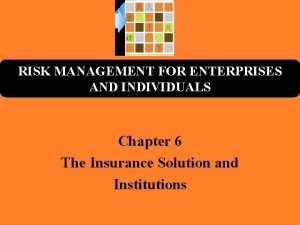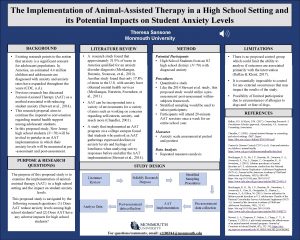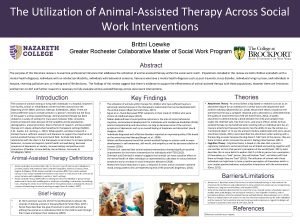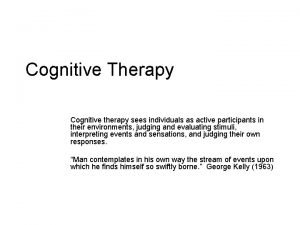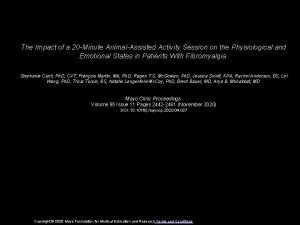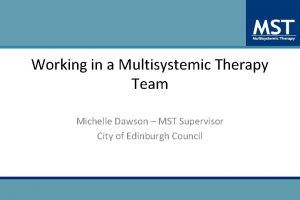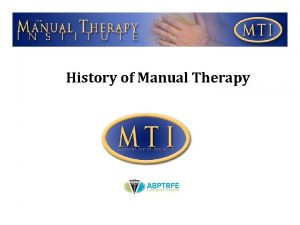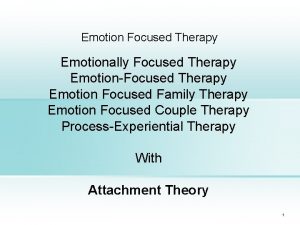ANIMALASSISTED THERAPY WITH INDIVIDUALS AND GROUPS T Dawson



































- Slides: 35

ANIMAL-ASSISTED THERAPY WITH INDIVIDUALS AND GROUPS T. Dawson Woodrum, MA JD and Parker © August 2018

Animal-assisted Therapy (AAT) • What we will cover today • • • The basics – what is it and how long has it been around? Current state of the literature – does it work? Potential mechanism(s) of action – how does it work? Legalities – therapy v. emotional support v. service animal Contraindications Potential risks www. fielding. edu

AAT: Basics • Definition: “AAT is the deliberate inclusion of an animal in a treatment plan” (Nimer & Lundahl, 2007, p. 225). • • • Predefined outcomes difficult to achieve w/o exposure to live animal Used as an adjunct to or in conjunction with other interventions Goal directed (Rossetti & King, 2010) Delivered/directed by healthcare provider w/i scope of profession Documented process www. fielding. edu

AAT: Basics • Animal assisted therapy is not “new” • Freud “informally practiced” AAT • His dog was often present in the room during sessions • He would comment on the dog’s “… behavior and moods to his clients, referring to them as a reflection of processes happening in the client”. 1 • First mentioned in US research literature by child psychologist Boris Levinson • Levinson hypothesized that his dog provided a “communication link” while working with disturbed children. 2 www. fielding. edu

AAT: Basics • Animals used • Dogs, horses, cats, guinea pigs, farm animals, dolphins… • Settings • Hospitals, clinics, counseling centers, private practice offices, farms, camps, riding facilities, etc. • May be used in individual or group treatment formats www. fielding. edu

AAT: Basics • Treatment populations vary • Severe mental illness, refugees, at risk youth, nursing home residents, neurodiverse, cognitive impairment, trauma, depression, anxiety • Young children, adolescents, adults, elderly • Interventionist varies • • Psychologist Counselor Social Worker Equine specialist, dog handler etc. www. fielding. edu

AAT– State of the Literature • Large number of case studies and “poorly controlled” studies • Lack of large randomized studies using control groups • Large variation in AAT delivery • • Setting (inpatient/outpatient, field, etc. ) Duration of study (long/short term) and frequency of animal interaction Format (group/individual) Age of participants (children, adults, elderly) Underlying treatment target (physical, mental, well-being) Type of animal used (most are dogs or horses) Some studies included Animal Assisted Activities (AAA) (pets) • Studies conducted in 1980 s-90 s provided mixed results www. fielding. edu

AAT– Meta Analyses www. fielding. edu

AAT– State of Literature (Meta) www. fielding. edu

AAT– State of Literature (Meta) • Review of randomized controlled trials (Kamioka et al. , 2014) • 11 studies involved RCT AAT • Multiple types of animals used (dog, cat, dolphin, bird, cow, rabbit, ferret, and guinea pig) • AAT only (>1 day intervention with live animal) • Authors concluded meta-analysis could not be performed because of heterogeneity in outcome measurements and intervention methods (Kamioka et al. , 2014, p. 384) • Concluded that the studies provide directional support for AAT • Called for higher quality randomized controlled trials of AAT to further support claims regarding efficacy and mechanisms of action www. fielding. edu

AAT– Construct Validity • Meta-analysis of AAT and AAA (Marino, 2012) • Examined construct validity: is a live animal necessary or is it just the effect of having a “novel stimulus” in the room? • Reviewed 28 additional studies that had not been included in prior meta analyses by Nimer & Lundahl (2007) and Souter & Miller (2007) • Supported prior studies findings that AAT/AAA associated with moderate and broad effect size but that construct validity is still in question (where the living animal is necessary for effectiveness) • One study, using a robotic dog found no statistically significant difference in outcomes (reduced loneliness in elderly nursing home patients) when compared to a live dog treatment group! (Banks, Willoughby, & Banks, 2008) www. fielding. edu

Potential Mechanisms of Action • Promote a natural tendency to create a bond with other living things (biophilia)1 • Promote an accepting/humanizing atmosphere 1, 7 • Serve as a transitional and relational object to aid in facilitating the client-therapist relationship (facilitate establishment of rapport, rupture repair)2, 6, 7, 12, 13 • Serve as a catalyst for emotion, lightening a mood, or emotional regulation 2, 9 • Ease social tensions and promote social interaction 2, 4, 5, 7, 8. 11 • Increase focus and social awareness 2 • Improve nonverbal communication 2 • Provide pleasurable physical/tactile and mental stimulation 3, 9 • Provide positive physiological effects (e. g. , lower blood pressure, relaxation)3, 9, 10 • Buffer effects of stress, provide coping support, and improve distress tolerance 4, 9, 10, 13 • Enhance self esteem 7, 10, 11 www. fielding. edu

Observed Psychological Benefits • • • Reduced number of problem behaviors 1, 4, 9, 11 Reduced number of sxs associated with ASD 1, 5 Improved overall sense of well-being 1, 12 Reduced sxs associated with depression 2, 4, 15 Improved ability to manage anger 2 and reduced violence 7 Reduced sxs of anxiety 2, 4, 13, 15 Reduced loneliness 3 Improved psychosocial adaptation and motivation 6, 9, 12, 14, 15 Reduced sxs associated with PTSD 8, 15 Improved cognitive fx (in elderly with ALZ)10 www. fielding. edu

Legalities • Therapy animal – any species • There is no central “certifying body”; primarily done by private organizations • “Buyer beware” – review organization and their screening, testing and ongoing evaluation procedures • Emotional support animal (ESA) – any species • A animal that a professional healthcare provider has determined is needed to address the owner’s diagnosed disability (but no defined task beyond companionship/comfort) • ADA requires accommodation (e. g. , no extra fees) in housing and public transportation but not in areas where animals are not allowed • Unlike service animal, airlines/landlords may request letter from healthcare provider establishing disability and need for an ESA www. fielding. edu

Legalities • Service animal – applies to dogs (and mini-horses now) • ADA: “Any dog that is individually trained to do work or perform tasks for the benefit of an individual with a disability, including a physical, sensory, psychiatric, intellectual, or other mental disability. ” • “Task” is not general comfort or support – this would be an ESA • NOT treated as a “pet” by law – must be allowed wherever disabled person goes (unless there is a safety issue) as well as in housing and public transportation • There is no central “certification” or training requirement (People with disabilities have the right to train the dog themselves and are not required to use a professional service dog training program) www. fielding. edu

Legalities • Service animal – applies to dogs (and mini-horses now) • Service dog owners are obligated to keep the dog under control and the dog must be housebroken • Legally, if a client wants to bring a service dog to sessions, you can only ask 2 questions: • • Is the dog a service dog required b/c of a disability? What work or task does it perform? • You may NOT • • • Ask to see the dog demonstrate the task Ask about the nature of the disability Demand to see a “certificate” or require the dog wear a vest • Allergies and phobias are NOT grounds to refuse services to a person accompanied by a service dog www. fielding. edu

Contraindications to AAT • Client is fearful or allergic • Client has any other medical condition that may be aggravated by presence of animal • Client has religious/cultural background that prohibits interaction with animal (but… don’t “assume”) www. fielding. edu

Potential Risks • • • Bites (canine, equine, feline) Scratches (canine, feline) Riding accident (equine) Grief (termination of interaction) Property damage Zoonotic infections www. fielding. edu

From the Client’s Perspective… www. fielding. edu

QUIZ 1. The primary difference b/w a service animal and an emotional support animal is that a service animal has a specific task to perform beyond general companionship or comfort. T/F 2. A landlord can demand a prospective tenant provide a letter documenting a service animal has been recommended by a health care professional to provide companionship/comfort to a prospective tenant due to a diagnosed disability. T/F 3. Animal assisted therapy (AAT) and Animal assisted activities (AAA) are the same thing. T/F www. fielding. edu

QUIZ 4. Meta-analyses have provided directional support for the effectiveness of animal-assisted therapy. T/F 5. More research is needed to understand whether a live animal is a necessary element for animal-assisted therapy. T/F 6. Animal-assisted therapy must take place in controlled clinical settings. T/F 7. Animal-assisted therapy requires inclusion of an animal in a treatment plan. T/F www. fielding. edu

QUIZ 8. A therapy dog is most like: (a) an emotional support animal for many people; or (b) a service dog for many people. 9. A service dog cannot be a therapy dog. T/F 10. An emotional support animal cannot be a therapy dog. T/F 11. The kinds of questions that can be asked or documentation that can be required for an emotional support animal and service animal are the same. T/F 12. A therapy dog must be under the control of the handler. T/F www. fielding. edu

QUIZ 13. Name one risk that needs to be evaluated when considering incorporating the use of a therapy animal. 14. By law, service animals are limited to one or two types of species? Name it/them. 15. By law, what species of animals are addressed under laws governing ESAs? Therapy animals? 16. Jim has a service dog and wants to join a therapy group that has been meeting for about 6 months. One of the early group members is highly allergic to dogs. What should therapist do? www. fielding. edu

QUIZ 17. A person with a service dog enters a business. The dog is jumping up on customers (who have not engaged with the dog). The dog is also knocking merchandize off the shelf and ”marking”. Can the business owner ask the person to leave? Why or why not? 18. Terry owns a rental residential property. He charges extra monthly fees for tenants who have pets to recoup costs for cleaning and wear and tear. Terry’s new tenant has presented a letter stating the cat he has on the property is an ESA. Can Terry continue to charge these fees? If not, what other options does Terry have to pass on the cleaning and wear/tear costs? www. fielding. edu

QUIZ 19. What are some of the proposed “mechanisms of action” for explaining the beneficial effect of animal-assisted therapy? 20. Is there a law (or laws) that penalizes people for interfering with a service animal (e. g. , teasing it, demanding a demonstration of what it does, preventing it from entering a place of business with the owner, etc. )? www. fielding. edu

Videos • Animal assisted therapy (dog - discussion) https: //youtu. be/J 1 y. A_j. Pcj. Eo • Animal assisted therapy (dog – demonstration with child) https: //youtu. be/yo_WI 054 Pvo • Animal assisted therapy (horse – discussion) https: //youtu. be/Phsyw. Fkf. Es. A • Animal assisted therapy (horse – demonstration with veterans) https: //youtu. be/qx-UTXE 1 Mb. M www. fielding. edu

Questions? www. fielding. edu

References Amerine, J. (2016). Using animal-assisted therapy to enrich psychotherapy. Advances in Mind-Body Medicine, 30(3), 11– 18. Bachi, K. , & Parish-Plass, N. (2017). Animal-assisted psychotherapy: A unique relational therapy for children and adolescents. Clinical Child Psychology and Psychiatry, 22(1), 3– 8. Balluerka, N. , Muela, A. , Amiano, N. , & Caldentey, M. A. (2015). Promoting psychosocial adaptation of youths in residential care through animal-assisted psychotherapy. Child Abuse & Neglect, 50, 193– 205. https: //doi. org/10. 1016/j. chiabu. 2015. 09. 004 Banks, M. R. , Willoughby, L. M. , & Banks, W. A. (2008). Animalassisted therapy and loneliness in nursing homes: Use of robotic versus living dogs. Journal of the American Medical Directors Association, 9(3), 173– 177. https: //doi. org/10. 1016/j. jamda. 2007. 11. 007 www. fielding. edu

References Breslau, S. D. (2015). A cigar Is sometimes just a cigar, but a dog Is never just a dog. International Journal of Group Psychotherapy, 65(1), 115– 123. https: //doi. org/10. 1521/ijgp. 2015. 65. 1. 115 Cherniack, E. P. , & Cherniack, A. R. (2014). The benefit of pets and animal-assisted therapy to the health of older individuals. Current Gerontology and Geriatrics Research, 2014, 1– 9. https: //doi. org/10. 1155/2014/623203 Crossman, M. K. (2017). Effects of interactions with animals on human psychological distress. Journal of Clinical Psychology, 73(7), 761– 784. https: //doi. org/10. 1002/jclp. 22410 Every, D. , Smith, K. , Smith, B. , Trigg, J. , & Thompson, K. (2017). How can a donkey fly on the plane? The benefits and limits of animal therapy with refugees: Animal therapy with refugees. Clinical Psychologist, 21(1), 44– 53. https: //doi. org/10. 1111/cp. 12071 www. fielding. edu

References Germain, S. M. , Wilkie, K. D. , Milbourne, V. M. K. , & Theule, J. (2018). Animal-assisted psychotherapy and trauma: A meta-analysis. Anthrozoös, 31(2), 141– 164. https: //doi. org/10. 1080/08927936. 2018. 1434044 Kamioka, H. , Okada, S. , Tsutani, K. , Park, H. , Okuizumi, H. , Handa, S. , … Mutoh, Y. (2014). Effectiveness of animal-assisted therapy: A systematic review of randomized controlled trials. Complementary Therapies in Medicine, 22(2), 371– 390. https: //doi. org/10. 1016/j. ctim. 2013. 12. 016 Maber-Aleksandrowicz, S. , Avent, C. , & Hassiotis, A. (2016). A systematic review of animal-assisted therapy on psychosocial outcomes in people with intellectual disability. Research in Developmental Disabilities, 49– 50, 322– 338. https: //doi. org/10. 1016/j. ridd. 2015. 12. 005 www. fielding. edu

References Maber-Aleksandrowicz, S. , Avent, C. , & Hassiotis, A. (2016). A systematic review of animal-assisted therapy on psychosocial outcomes in people with intellectual disability. Research in Developmental Disabilities, 49– 50, 322– 338. https: //doi. org/10. 1016/j. ridd. 2015. 12. 005 Marino, L. (2012). Construct validity of animal-assisted therapy and activities: How important Is the animal in AAT? Anthrozoös, 25(sup 1), s 139–s 151. https: //doi. org/10. 2752/175303712 X 13353430377219 Maujean, A. , Pepping, C. A. , & Kendall, E. (2015). A systematic review of randomized controlled trials of animal-assisted therapy on psychosocial outcomes. Anthrozoös, 28(1), 23– 36. https: //doi. org/10. 2752/089279315 X 14129350721812 www. fielding. edu

References Menna, L. F. , Santaniello, A. , Gerardi, F. , Di Maggio, A. , & Milan, G. (2016). Evaluation of the efficacy of animal-assisted therapy based on the reality orientation therapy protocol in Alzheimer’s disease patients: a pilot study: AAT based on the ROT protocol. Psychogeriatrics, 16(4), 240– 246. https: //doi. org/10. 1111/psyg. 12145 Muckle, J. , & Lasikiewicz, N. (2017). An exploration of the benefits of animal-assisted activities in undergraduate students in Singapore. Asian Journal of Social Psychology, 20(2), 75– 84. https: //doi. org/10. 1111/ajsp. 12166 Muela, A. , Balluerka, N. , Amiano, N. , Caldentey, M. A. , & Aliri, J. (2017). Animal-assisted psychotherapy for young people with behavioural problems in residential care. Clinical Psychology & Psychotherapy, 24(6), O 1485–O 1494. www. fielding. edu

References Nimer, J. , & Lundahl, B. (2007). Animal-assisted therapy: A metaanalysis. Anthrozoös, 20(3), 225– 238. https: //doi. org/10. 2752/089279307 X 224773 Nurenberg, J. R. , Schleifer, S. J. , Shaffer, T. M. , Yellin, M. , Desai, P. J. , Amin, R. , … Montalvo, C. (2015). Animal-assisted therapy with chronic psychiatric inpatients: Equine-assisted psychotherapy and aggressive behavior. Psychiatric Services, 66(1), 80– 86. https: //doi. org/10. 1176/appi. ps. 201300524 O’Haire, M. E. (2013). Animal-Assisted Intervention for Autism Spectrum Disorder: A Systematic Literature Review. Journal of Autism and Developmental Disorders, 43(7), 1606– 1622. https: //doi. org/10. 1007/s 10803 -012 -1707 -5 www. fielding. edu

References O’Haire, M. E. , Guérin, N. A. , & Kirkham, A. C. (2015). Animal. Assisted Intervention for trauma: a systematic literature review. Frontiers in Psychology, 6. https: //doi. org/10. 3389/fpsyg. 2015. 01121 Rossetti, J. , & King, C. (2010). Use of animal-assisted therapy with psychiatric patients: A literature review. Journal of Psychosocial Nursing, 48(11), 45– 48. Rothberg, B. , & Collins, E. (2015). A service dog in group. International Journal of Group Psychotherapy, 65(2), 307– 315. Souter, M. A. , & Miller, M. D. (2007). Do animal-assisted activities effectively treat depression? A meta-analysis. Anthrozoös, 20(2), 167– 180. https: //doi. org/10. 2752/175303707 X 207954 www. fielding. edu

References Virués-Ortega, J. , Pastor-Barriuso, R. , Castellote, J. M. , Población, A. , & de Pedro-Cuesta, J. (2012). Effect of animal-assisted therapy on the psychological and functional status of elderly populations and patients with psychiatric disorders: a meta-analysis. Health Psychology Review, 6(2), 197– 221. https: //doi. org/10. 1080/17437199. 2010. 534965 Wilkie, K. D. , Germain, S. , & Theule, J. (2016). Evaluating the efficacy of equine therapy among at-risk youth: A meta-analysis. Anthrozoös, 29(3), 377– 393. https: //doi. org/10. 1080/08927936. 2016. 1189747 Zilcha-Mano, S. (2017). Resolution of alliance ruptures: The special case of animal-assisted psychotherapy. Clinical Child Psychology and Psychiatry, 22(1), 34– 45. https: //doi. org/10. 1177/1359104516671385 www. fielding. edu
 Individuals groups and institutions
Individuals groups and institutions The activities that independent individuals groups
The activities that independent individuals groups How are ethnic groups and religious groups related
How are ethnic groups and religious groups related Dawson and evans static base
Dawson and evans static base Dawson and evans static base
Dawson and evans static base Types of transactions in transactional analysis
Types of transactions in transactional analysis Psychodynamic and humanistic therapies have in common
Psychodynamic and humanistic therapies have in common Bioness integrated therapy system occupational therapy
Bioness integrated therapy system occupational therapy Humanistic therapies aim to boost
Humanistic therapies aim to boost Dawson engler
Dawson engler Mr. dawson tamatea
Mr. dawson tamatea Dawson engler
Dawson engler Ian dawson thinking history
Ian dawson thinking history Thearin dawson
Thearin dawson Dawson trotman born to reproduce
Dawson trotman born to reproduce Dawson model un
Dawson model un Hypersignaux flair sus tentoriels
Hypersignaux flair sus tentoriels Shawndell dawson
Shawndell dawson Dawson model un
Dawson model un Building operation system
Building operation system Ciaran dawson
Ciaran dawson Becca dawson
Becca dawson Ccg consulting
Ccg consulting Dawson fingers ms
Dawson fingers ms Micardite
Micardite Dedos de dawson
Dedos de dawson Thinking history.co.uk
Thinking history.co.uk Ian dawson thinking history
Ian dawson thinking history Manufacturing cost variance analysis
Manufacturing cost variance analysis Flexner e dawson
Flexner e dawson Lawrence meats dawson creek
Lawrence meats dawson creek Risk management for enterprises and individuals
Risk management for enterprises and individuals Empathy and establishing trust with individuals
Empathy and establishing trust with individuals Serving individuals and families
Serving individuals and families Serving individuals and families
Serving individuals and families Define family matters
Define family matters





